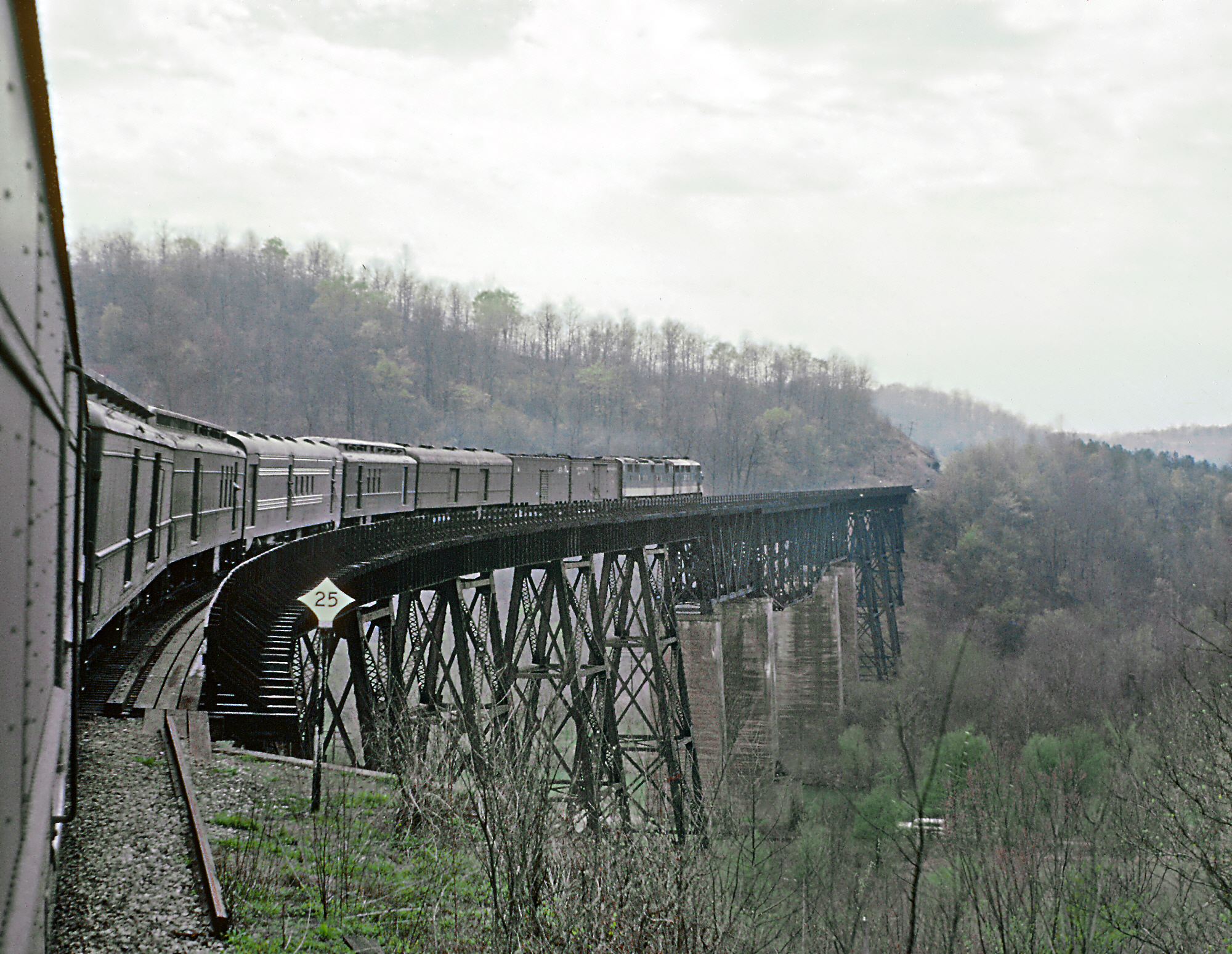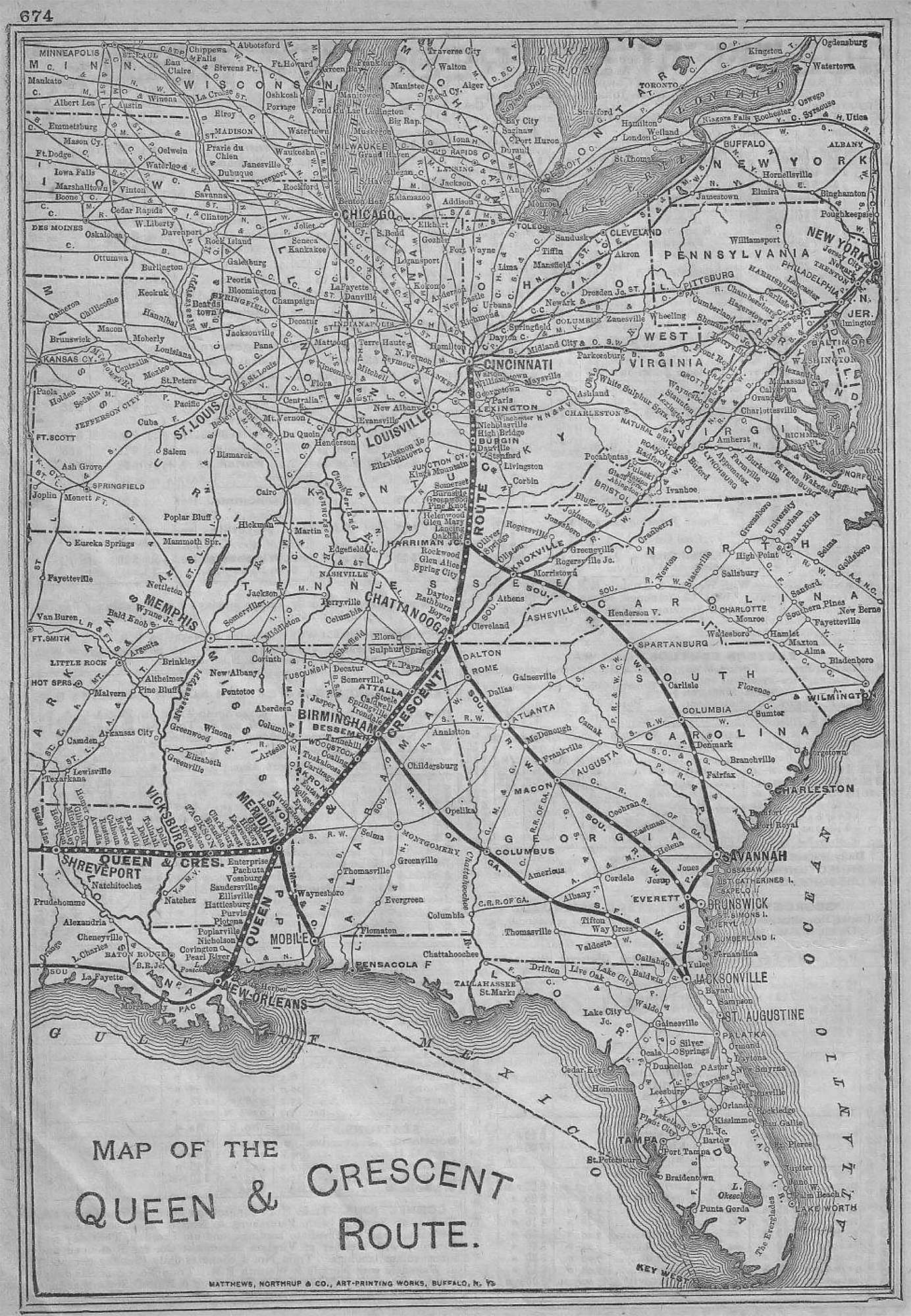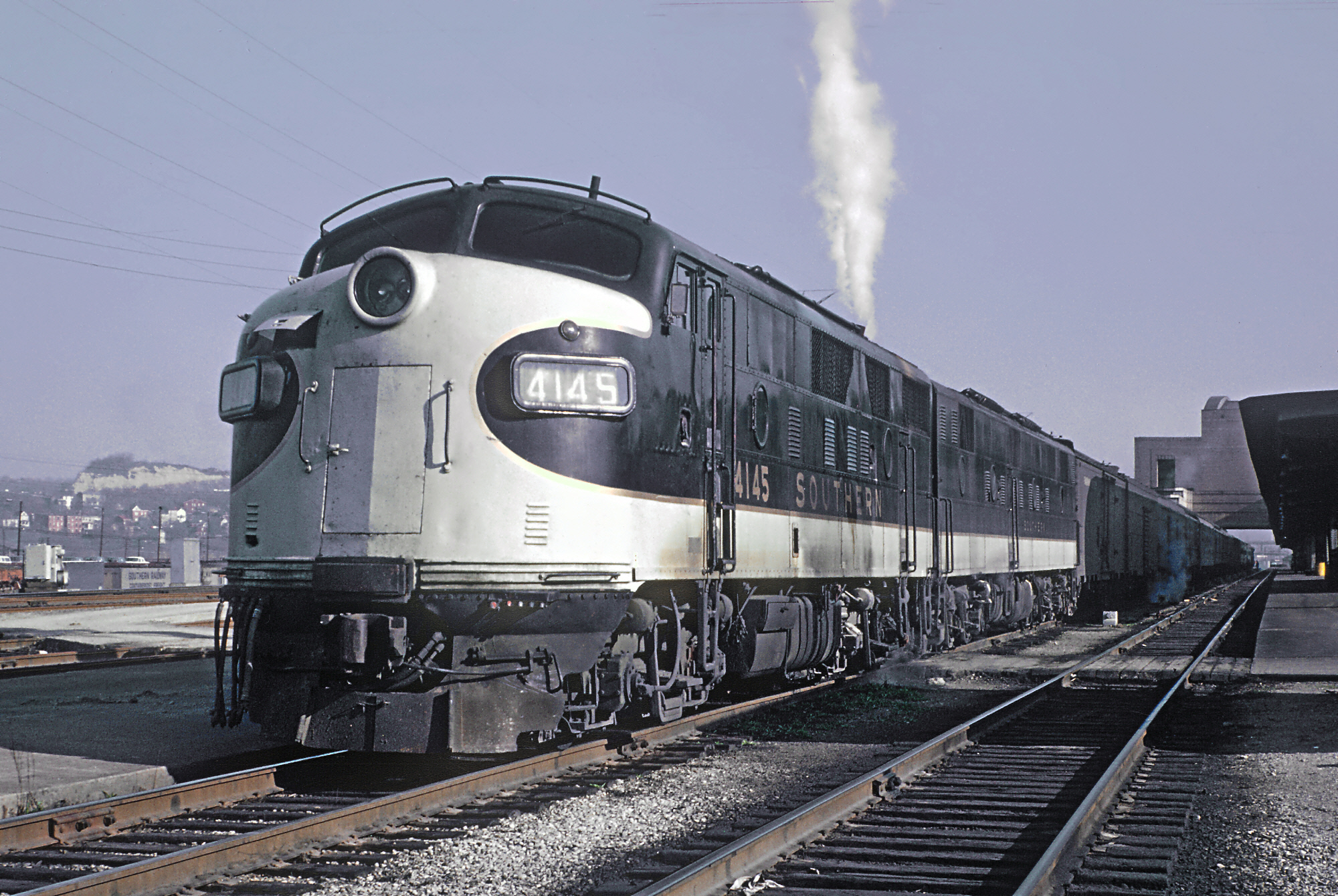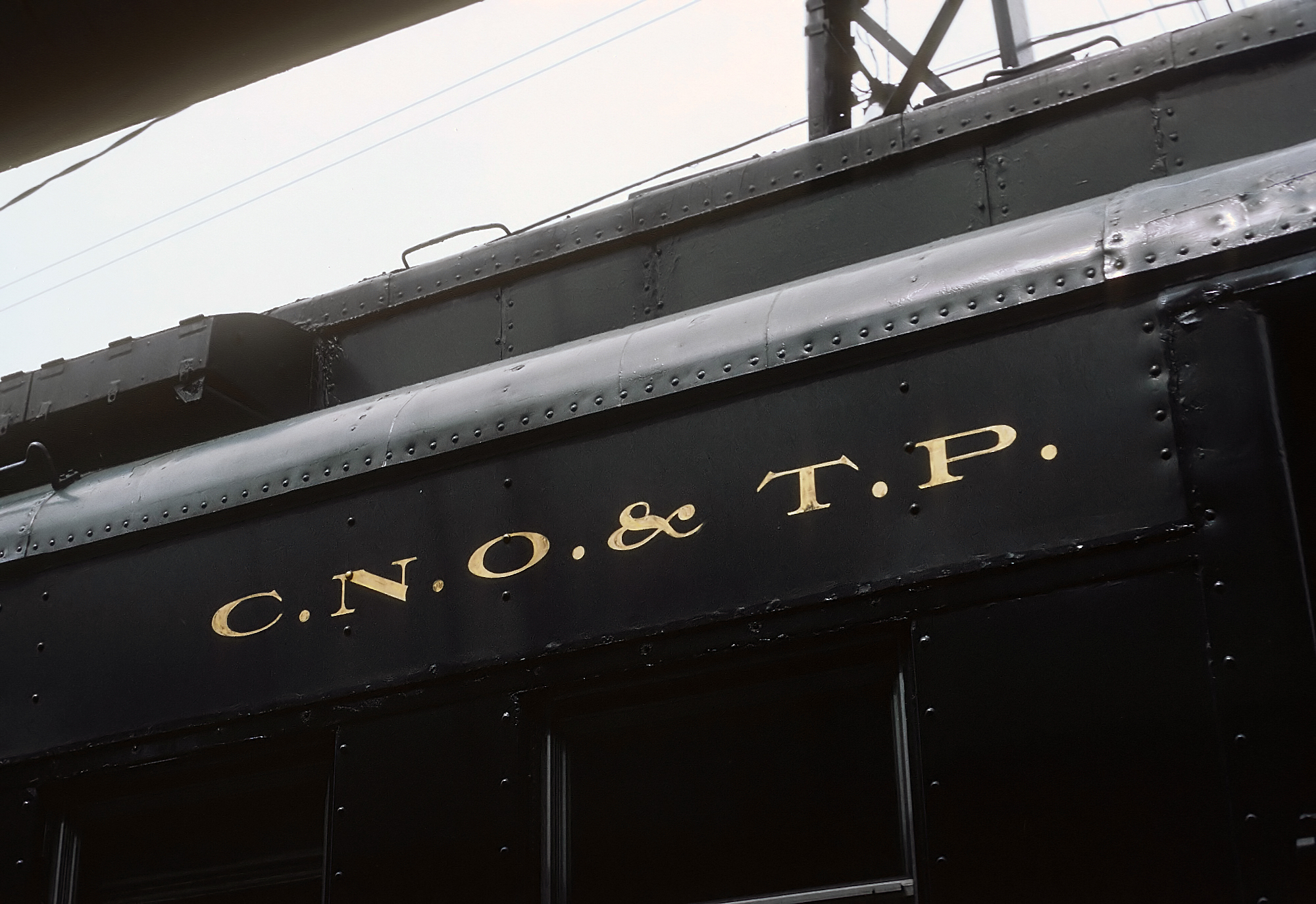Cincinnati, New Orleans and Texas Pacific Railway
Last revised: August 23, 2024
By: Adam Burns
The Cincinnati, New Orleans and Texas Pacific Railway (CNO&TP), also known as the "Queen and Crescent Route," is a railroad that runs from Cincinnati, Ohio, south to New Orleans, Louisiana, in the United States.
It was established in 1881 to provide a direct rail connection between the Midwest and the Southern United States. For most of its time in service the line has been operated by the Southern Railway and successor Norfolk Southern today.
The CNO&TP, a Southern/NS subsidiary, operates what is technically the Cincinnnati Southern Railway, a company which had been under ownership of the city of Cincinnati until November, 2022.
The line runs a total of 338 miles between Cincinnati and Chattanooga, Tennessee and acts as part of Norfolk Southern main line to New Orleans. The northern component is forced to tackle the southwestern region of the Appalachian Mountains.
It is fondly remembered as the "Rathole" for its once-numerous tunnels. Many of these bores have since been daylighted (removed) as the Southern/Norfolk Southern spent decades making the line more operationally efficient.
Photos
 Roger Puta captured this scene of Southern's train #3, the "Royal Palm," crossing the New River at New River, Tennessee along the CNO&TP on April 11, 1963.
Roger Puta captured this scene of Southern's train #3, the "Royal Palm," crossing the New River at New River, Tennessee along the CNO&TP on April 11, 1963.Genesis
The Cincinnati, New Orleans and Texas Pacific Railway (CNO&TP) embedded its inception in the minds of American industrialists in the late 19th century. An era marked by epochal leaps in railroad technology and the expansion of trade routes, it was amid this fervor that the CNO&TP was conceived.
The CNO&TP spanned a total of 338 miles between Gest Street Yard in Cincinnati and Terminal Station in Chattanooga.
While the corridor snaked its way through the southwestern edge of the Appalachian Mountain chain, which offered incredibly scenic views, it required a total of 105 bridges and 27 tunnels.
The line between Danville, Kentucky and Oakdale, Tennessee featured so many tunnels (23), crews soon dubbed the route as the "Rat Hole." During the Southern years it was referred to as the "Rathole Division."
Purpose
The CNO&TP was designed with the purpose of creating a strategic conduit to transport goods between the Midwestern and Southern states. Its construction aimed to streamline the distribution of resources across these regions, enhancing trade and economic connections.
The total cost of crafting this elaborate network was as monumental as the project itself, stretching upwards of $20 million during its inception. This price, though considerable, was justified by the long-term economic growth it promised.
The curtains drew back on the CNO&TP on February 21, 1880 as train whistles heralded the majestic emergence of a railway line designed to revolutionize American transportation.
Interestingly, the CNO&TP was known for leasing the Cincinnati Southern Railway, which was publicly owned by the city of Cincinnati. This unique arrangement allowed for improved integration and management of the railroad line. That finally changed in November, 2022 when the city sold the Cincinnati Southern Railway to Norfolk Southern for $1.62 billion.
During the 1880s the Cincinnati Southern became the northern component of the famed "Queen and Crescent Route". This elegant moniker is discussed in greater detail below but included several systems which provided a through route from Cincinnati to New Orleans.
System Map (1895)
 A system map of the Queen & Crescent Route from 1895. This corridor was collectively under the Southern's control and included the CNO&TP, Alabama Great Southern, New Orleans & Northeastern, Alabama & Vicksburg, and Vicksburg, Shreveport and Pacific Railway. American-Rails.com collection.
A system map of the Queen & Crescent Route from 1895. This corridor was collectively under the Southern's control and included the CNO&TP, Alabama Great Southern, New Orleans & Northeastern, Alabama & Vicksburg, and Vicksburg, Shreveport and Pacific Railway. American-Rails.com collection.Queen and Crescent Route
The name "Queen and Crescent Route" was inaugurated on January 31, 1881. This marked the completion of a multi-year project overseen by Emile Erlanger and Company, an investment banking firm based in Paris, France, which had acquired several railroads between Cincinnati and New Orleans.
These included the Cincinnati Southern Railway (Cincinnati, New Orleans and Texas Pacific Railway), Alabama Great Southern Railroad, New Orleans and Northeastern Railroad, Alabama and Vicksburg Railway, and Vicksburg, Shreveport and Pacific Railway.
Piecing together these railroads was a significant infrastructure achievement in the post-Civil War, Reconstruction era of the American South.
The "Queen and Crescent" moniker was chosen as an homage to the cities the route connected, specifically Cincinnati, Ohio, known as the "Queen City," and New Orleans, Louisiana, famous for its Crescent-shaped bend in the Mississippi River.
Spanning over six Southern states, the Queen and Crescent Route provided pivotal transport links. It facilitated trade and human movement across Ohio, Kentucky, Tennessee, Alabama, Mississippi, and Louisiana. Consequently, it played a pivotal role in the industrialization and growth of these regions.
Altogether, the route spanned an impressive 835.8 miles in total. From Cincinnati, it journeyed southwards through Lexington, Chattanooga, and Birmingham, finally culminating in New Orleans. Its extent provided a direct and efficient passage between the North and the booming South.
The Southern Railway system acquired the Queen and Crescent Route on January 30th, 1895. This marked a significant step in the consolidation efforts of the sprawling American railroad industry. The Southern retained the "Queen and Crescent Route" name for many years.
It also launched a train with the same name, the Queen & Crescent Limited," which operated from April 26, 1925 until 1949.
Emile Erlanger and Company was instrumental in financing the original development of the Queen and Crescent Route. The company also played a key role in creating a unified system out of the five independent railway services that originally composed the route.
The Queen and Crescent Route was more than just a way of getting from one place to another; it was a conduit of cultural exchange. It fostered interconnectivity between the industrial North and the agricultural South helping to shape the America we know today.
In the subsequent decades, the route's importance has not diminished. It remains a vital artery in the national freight network. Even though the original passenger service was discontinued, the legacy of the route in terms of transport and connectivity endures. In addition, it remains an important artery today under Norfolk Southern.
Conclusively, theroute has seen transformations, acquisitions, and a shift in purpose. However, it remains a historic monument of the American South's industrial growth and testament to the vision of Emile Erlanger and Company, while its legacy under the Southern Railway banner remains indisputable.
Its historical importance, its impact on trade and community development and the dynamics it catalyzed are worthy of our appreciation for the Queen and Crescent Route.
Rathole Division
Despite its opulent nickname, the CNO&TP also bore the less grandiose title of the "Rathole.” This was predominantly due to its network of extensive tunnels and the challenging terrain it navigated - between Danville, Kentucky and Oakdale, Tennessee - reminiscent of a rat's subterranean journey.
Due to the line's importance, the Southern worked hard over the years to remove many of the corridor's tunnels, a project that had largely been completed by the 1960s.
Impacting more than simply logistics and economy, the existence of the CNO&TP prompted increased migration and urbanization in the served states. It was instrumental in shaping the social fabric of the American South during the late 19th and early 20th centuries.
 Southern F3A #4145 has train #3, the southbound "Royal Palm," awaiting departure from Cincinnati Union Terminal on April 11, 1963. Roger Puta photo.
Southern F3A #4145 has train #3, the southbound "Royal Palm," awaiting departure from Cincinnati Union Terminal on April 11, 1963. Roger Puta photo.Legacy
Changing hands between railway companies over time did not dilute the original essence of CNO&TP. Its purpose and values stayed alive, and it continued to provide essential connectivity between pivotal industrial regions.
In the present day, the legacy of the Cincinnati, New Orleans and Texas Pacific continues to cast long shadows over the American transportation system.
True to its raison d'être, the railway still serves as a notable freight route, facilitating the transport of goods such as coal, minerals, agricultural produce, and miscellaneous merchandise.
Though no longer a passenger railway, the transformation of CNO&TP into a freight railroad has not dimmed its significance. It remains a crucial part of the transportation tapestry, reflecting the enduring spirit of American industry.
Beyond the steel tracks and the rumble of locomotives, the Cincinnati, New Orleans and Texas Pacific serves as a living monument to the indomitable will of human endeavor and the relentless march of progress.
 CNO&TP sublettering on a Southern coach at Bluefield, West Virginia on September 19, 1970. Roger Puta photo.
CNO&TP sublettering on a Southern coach at Bluefield, West Virginia on September 19, 1970. Roger Puta photo.Its journey, marked by triumphs and trials, continues to be studied and revered by historians, railway enthusiasts, and college students alike, underpinning its timeless appeal.
Ultimately, the CNO&TP offers a testament to the ingenuity and perseverance of its visionaries who dared to dream and build this grand conduit of progress.
Still under the control of the Norfolk Southern Railway, the Queen and Crescent Route proudly stands as one of the crown jewels of American Railway history. Whether known as the bold "Cincinnati, New Orleans and Texas Pacific Railway" or the endearing "Rathole," its legacy persists, embedded in the heart of America's rail transportation heritage.
Recent Articles
-
New Mexico Railroad Museums: A Complete Guide
Apr 23, 25 02:25 PM
The enchanting state of New Mexico, known for its vivid landscapes and rich cultural heritage, is home to a number of fascinating railroad museums. -
New Hampshire Railroad Museums: A Complete Guide
Apr 23, 25 02:11 PM
New Hampshire, known for its breathtaking landscapes, historic towns, and vibrant culture, also boasts a rich railroad history that has been meticulously preserved and celebrated across various museum… -
Minnesota Railroad Museums: A Complete Guide
Apr 22, 25 12:17 PM
The state of Minnesota has always played an important role with the railroad industry, from major cities to agriculture. Today, several museums can be found throughout the state.